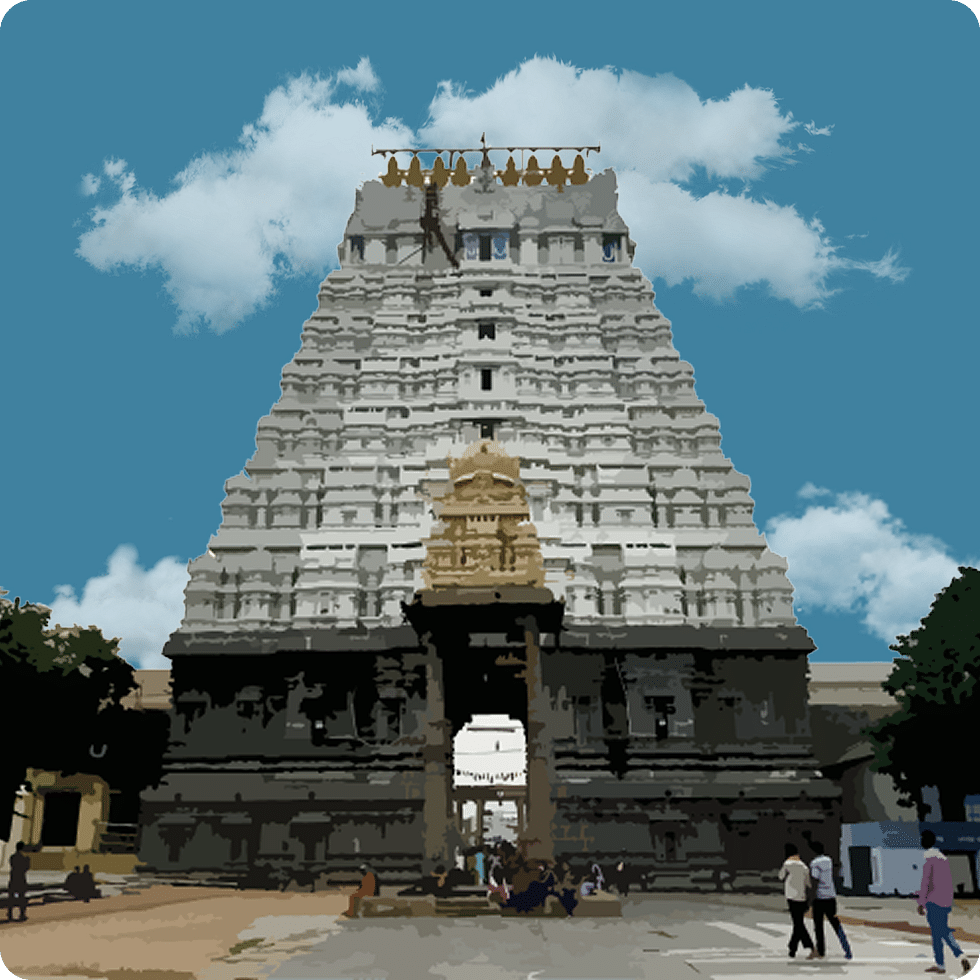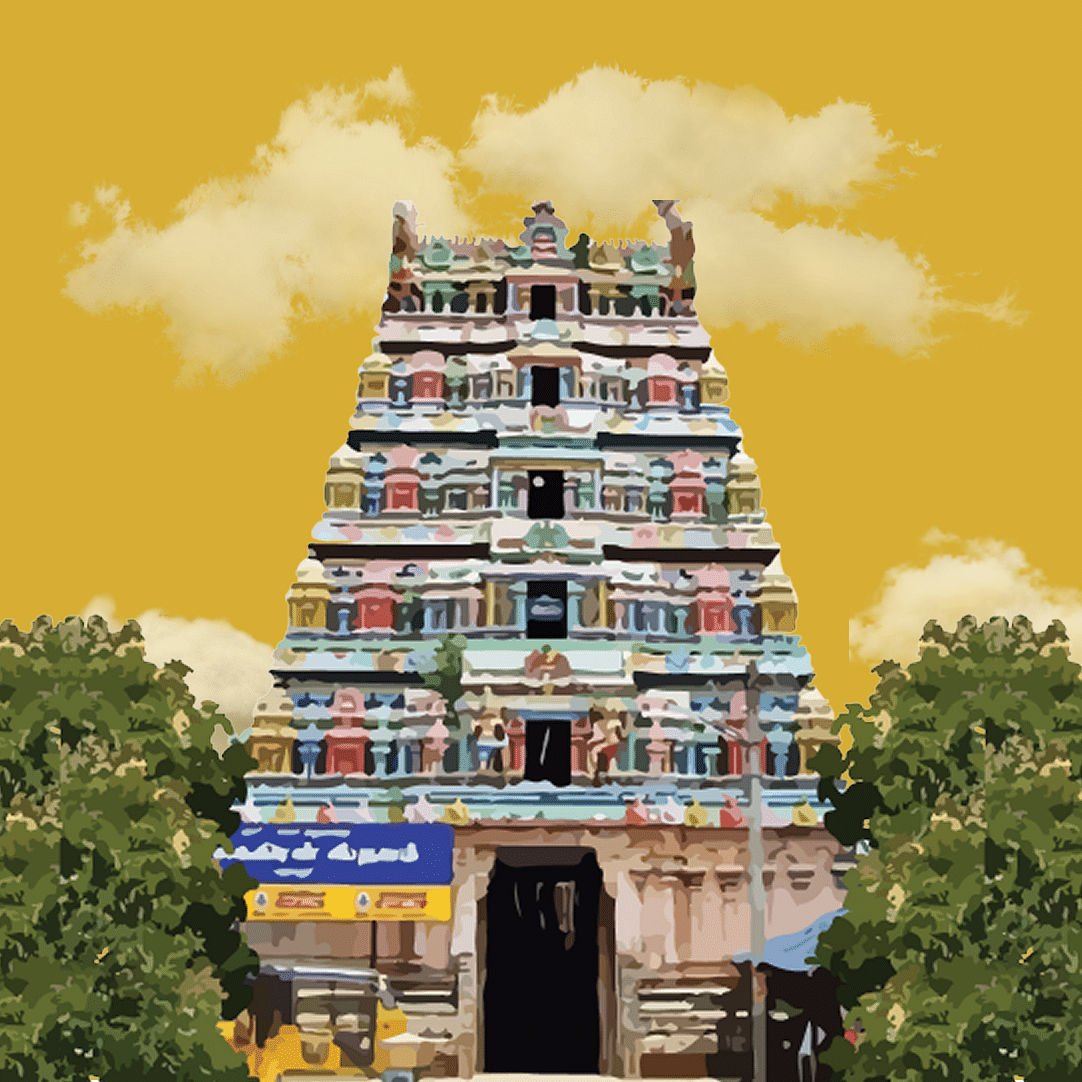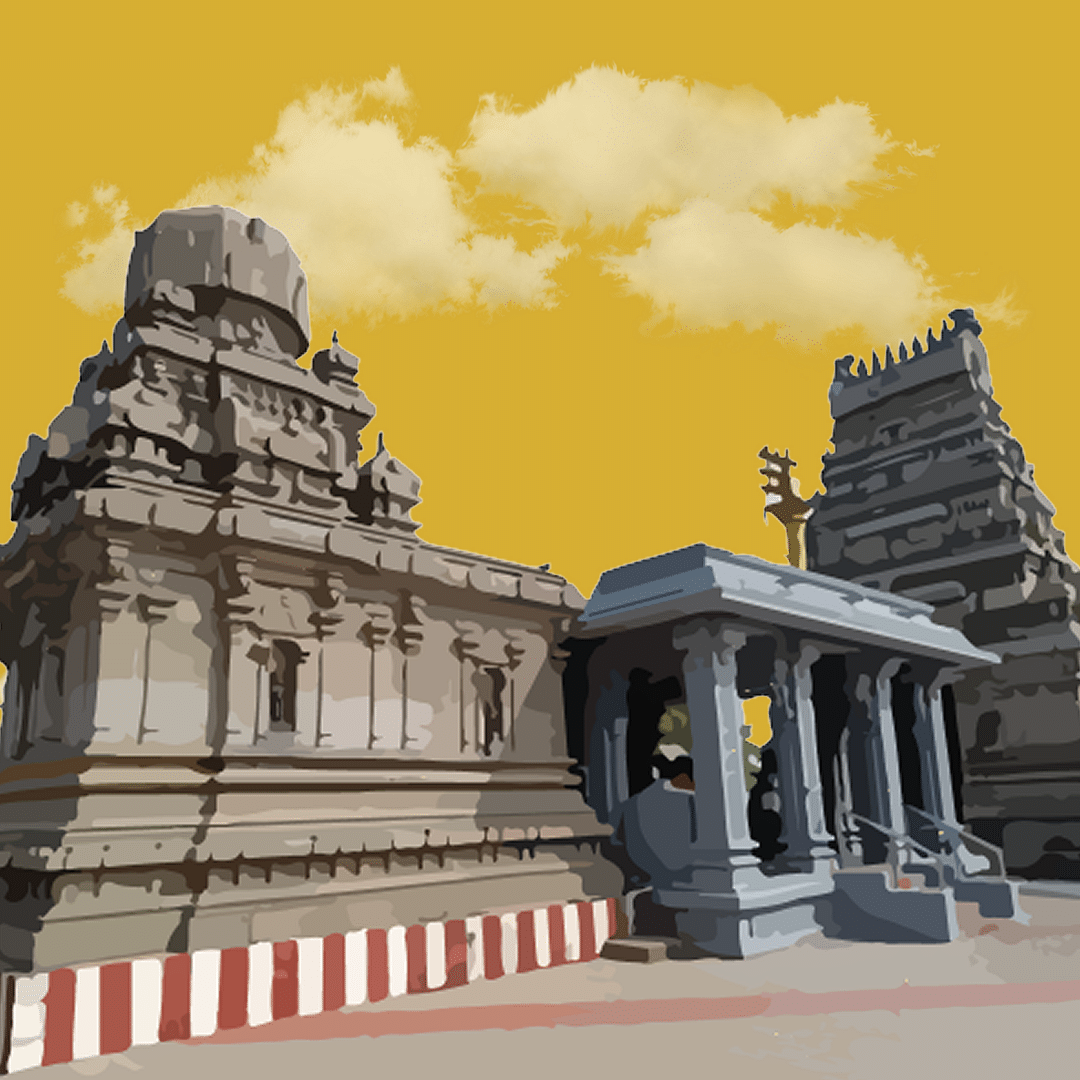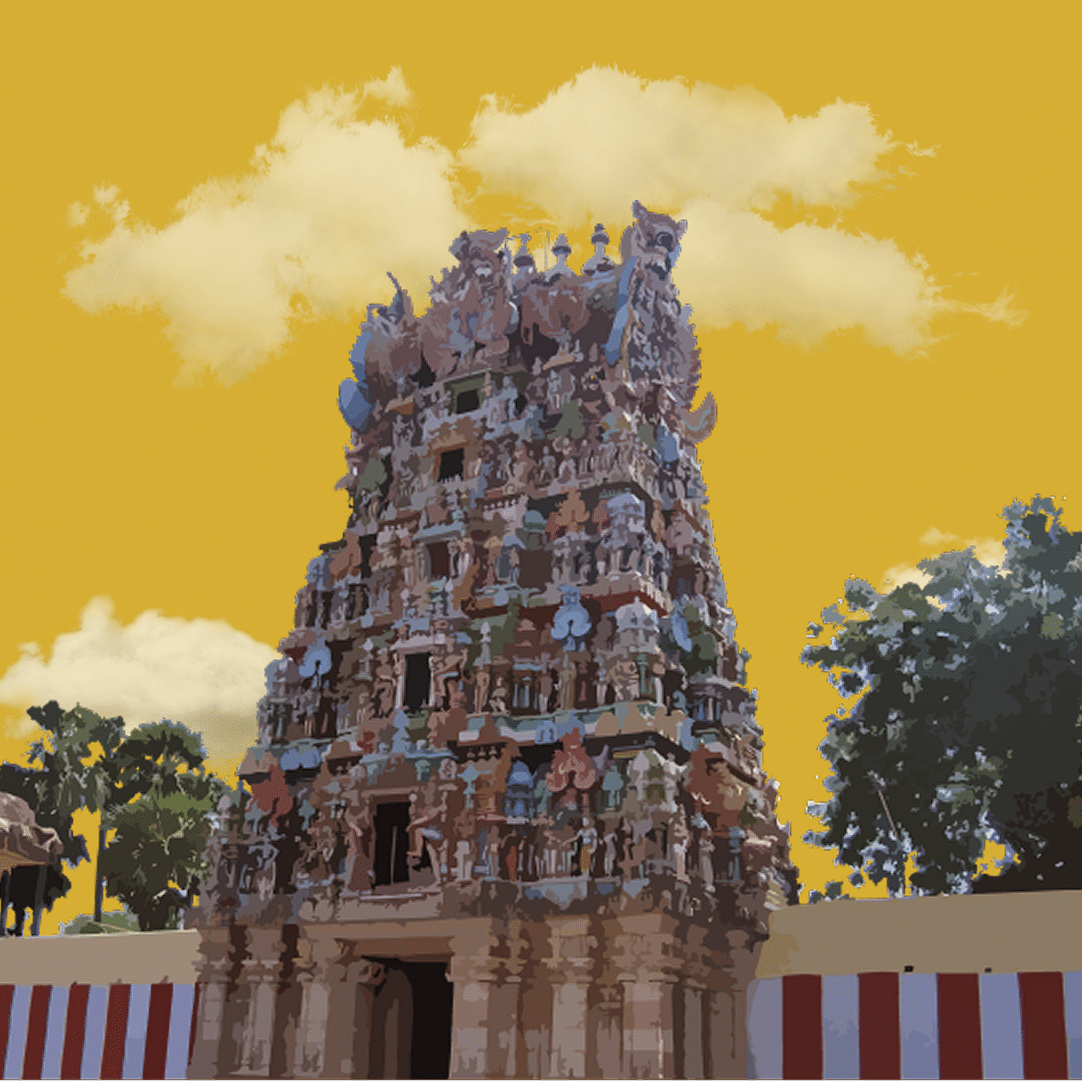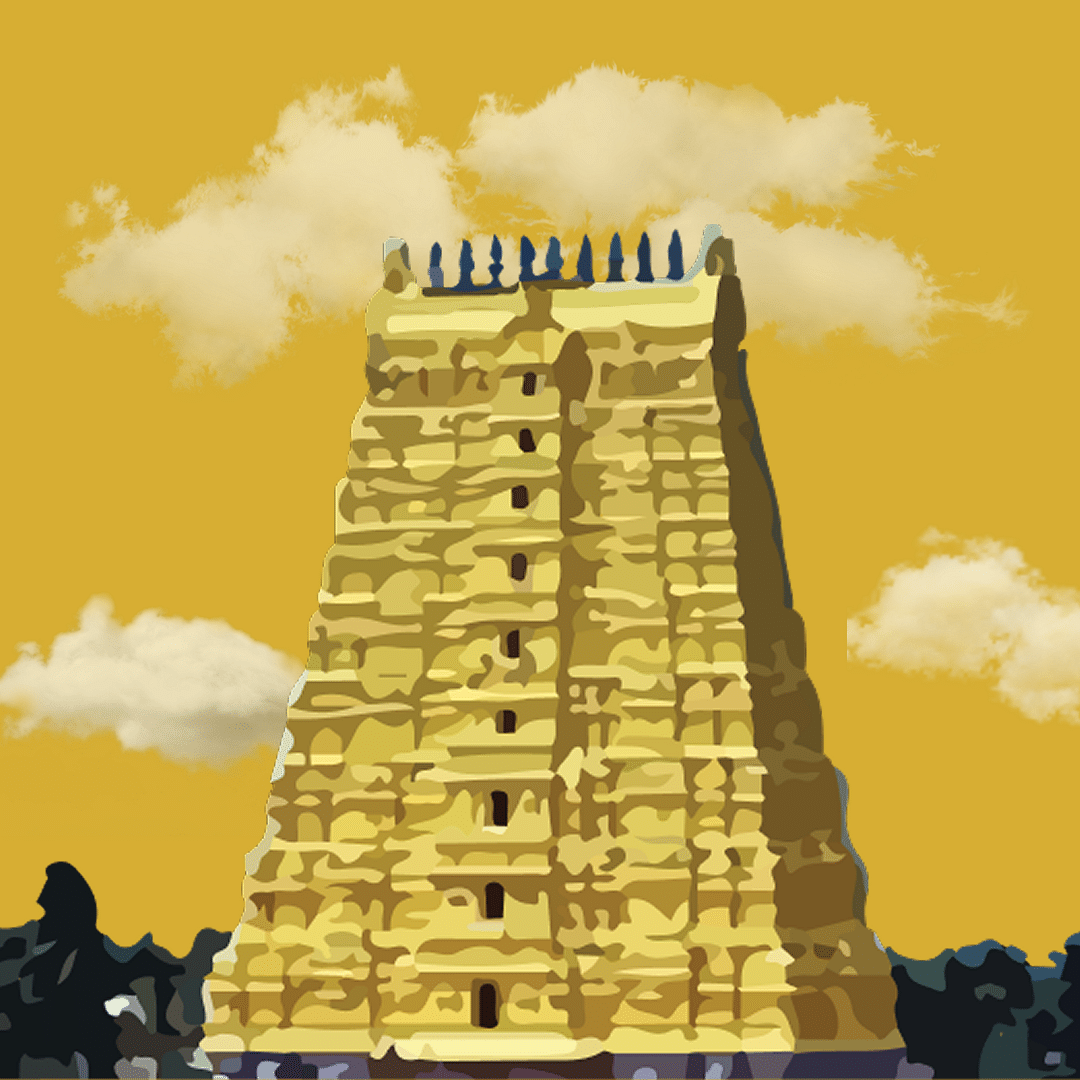Home > The GReaT Divine Darshan > Kanchipuram
HOLY PLACES
IN KANCHIPURAM
Kanchipuram isn’t just about silk sarees—there’s more woven into this city than threads of gold! Fondly called the Golden City of a Thousand Temples, it’s basically an open-air museum where the exhibits are ancient shrines, ringing their bells from dawn till dusk, casually reminding you to drop by. Each temple serves up a tale, a splash of grandeur, and enough jaw-dropping architecture to leave modern architects questioning their own design skills. If you're exploring temples in Kanchipuram, you're in for a treat. And just when you think you’ve seen it all, the Palar River calmly flows along the city’s edge, quietly adding its own peaceful rhythm to the sacred vibe of the place. A visit here is nothing short of a divine sightseeing spree, where even window shopping feels like receiving a blessing
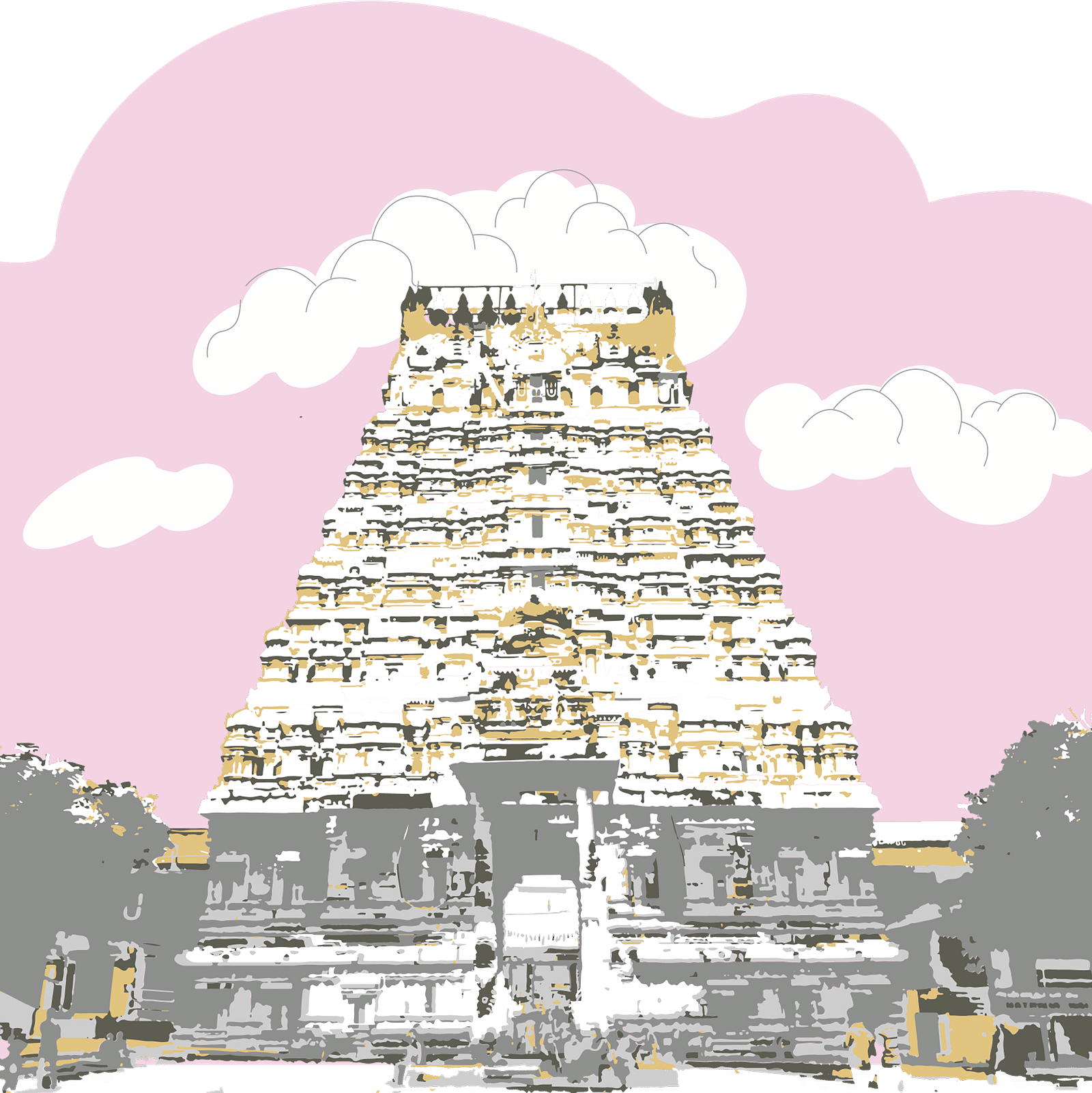
 OUR Hotels
OUR Hotels
IN THE CITY, BY THE SACRED SITES 🏙

Regency Kanchipuram by GRT Hotels
Just a stone’s throw away from the historic Kanchi Kamakoti Peetham Temple and the stunning Kailasanatha Temple, we’re the perfect haven for tired feet that can’t stop climbing temple steps. Our 30+ rooms, complete with cloud-like beds, let you sink in and forget about that 'temple step soreness' while you relax. Our multi-cuisine restaurant? It’s where tradition meets trend, and hygiene’s taken as seriously as a priest’s daily prayers. Whether you’re planning a Kalyanam (marriage) with your Kanmani or reuniting with your Class of '96 (like in that iconic movie), our banquets are ready to host whatever crazy idea you’ve cooked up. Whatever you’re dreaming of, we’ve already thought of it for you!
 OURDivine Destinations
OURDivine Destinations
TRAVEL THROUGH THE MUSEUMS OF FAITH 🛕
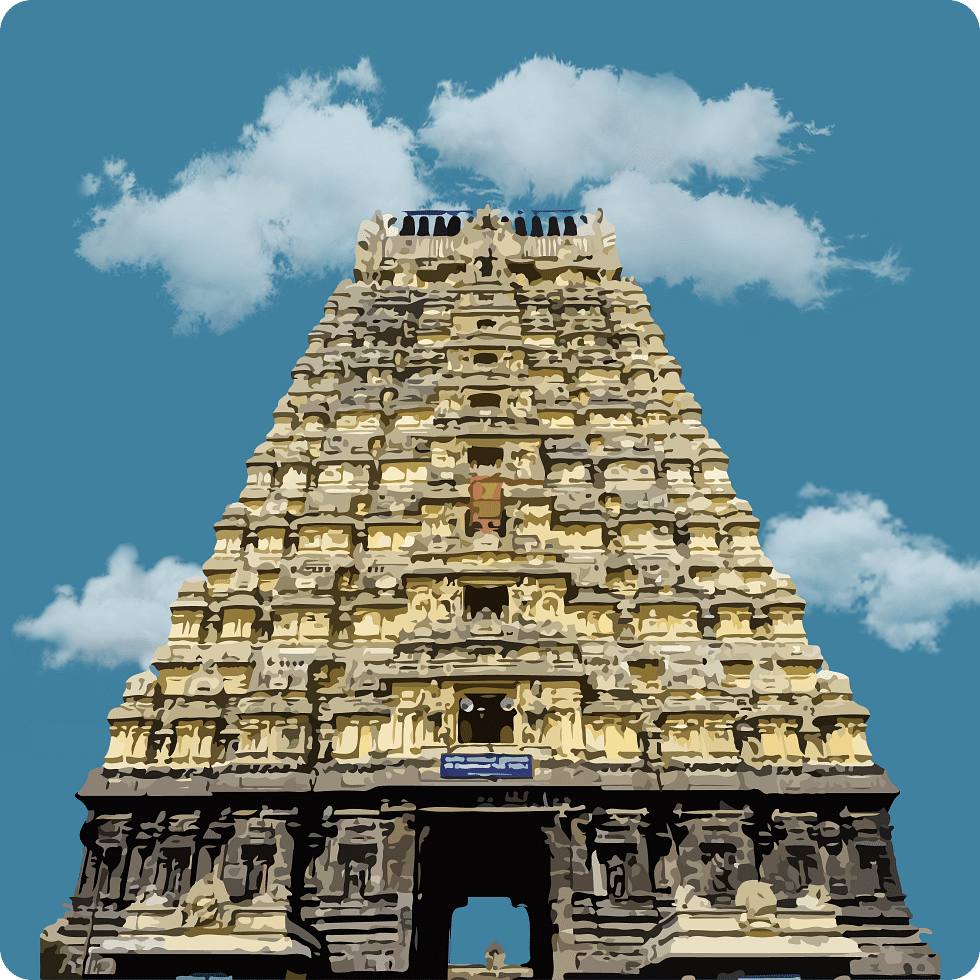
KAMATCHI AMMAN TEMPLE ✨
Goddess Kamakshi, with unwavering devotion, faced cosmic challenges to win Lord Shiva’s heart, including standing on a needle surrounded by fire. Shiva, impressed, appeared, and their celestial wedding marked the beginning of a divine love story in Kanchipuram!
Distance from Our Hotel3 km
Timing6:00 a.m. to 12:30 p.m.
3:45 p.m. to 8:00 p.m.FestivalMahotsavam: (Mar)
Maasi Pooram: (Mar)
Silver Chariot Festival: (Feb-Mar)
Float Festival: (Mar)
Navaratri: (Sep-Oct)
Aadi& Aippasi Pooram: (Jul-Sep)
Sankara Jayanthi: (Jun-Jul)
Vasantha Utsavam: (Jun-Jul)
Aadi Madham: (Jul)
Pongal: (Jan)Sacred Food OfferedPuliyodharai, Pongal, Curd rice
Transportation CostFor assistance, please contact the front desk.
Disclaimer: The temple's timings are subject to change as per the operating committee's decisions.
About Kamatchiamman Temple:
- The Kamakshi Temple is located in the historic city of Kanchipuram, Tamil Nadu, and is dedicated to Goddess Kamakshi, one of the highest aspects of Adi Parashakti, the supreme goddess in Shaktism.
- It is one of the most important centres of Shaktism in Tamil Nadu and attracts thousands of pilgrims and tourists each year.
- The temple’s origins date back to the 5th- 8th century AD and is believed to have been founded by the Pallava kings, whose capital was Kanchipuram. It was also suggested that it was built during the 14th century by the Cholas, while others claim it was constructed as recently as 1783.
- In addition to Kamakshi, the temple has a shrine for Vishnu in his form of Varaha.
- Kamakshi is worshipped in five different forms in the temple, representing different facets of her divine power.
- The temple is renowned for its Dravidian architecture, intricate carvings, and spiritual significance
Divine Facts:
Long ago, Goddess Kamakshi found herself in a fiery showdown with the demon Bhandasura. After the victory, she settled here at this temple, where her divine presence still radiates today. But Kamakshi’s story doesn’t stop at warrior mode. She had a new goal—to win Lord Shiva’s heart through pure, unshakable devotion. So, what did she do? She sculpted a Shiva idol with her hands, using nothing but the soil beneath her feet. Talk about DIY at its finest! But Lord Shiva, being the eternal cosmic examiner, decides to turn up the difficulty level. He transforms into the mighty Kamba River and sends waves crashing in, trying to wash away her idol. Kamakshi, however, isn’t one to be swept off her feet—literally. She holds on, probably thinking, Nice try, but I’ve seen tougher tests. Then, for the grand finale, she takes it up a notch—balancing on the tip of a needle while surrounded by five sacred fires. That’s right. While most of us struggle with a hot sidewalk in summer, she was basically standing in a celestial pressure cooker. Shiva, duly impressed, finally appears, and right there in Kanchipuram, their divine wedding takes place. Forget made in heaven—this was etched in temple stone. Fast-forward a bit, enter Rishi Durvasa—the sage famous for a fuse shorter than a temple elephant’s tail. He showed up, looking for peace, and Kamakshi, being the ultimate hostess, not only freed him from a curse but also inspired him to write the Saubhagya Chintamani Kalpa. Talk about a guest leaving with more than just prasadam!EKAMBARESHWARAR TEMPLE ✨
Goddess Parvati, with some serious determination and a little help from Vishnu, sculpted a Shiva Lingam out of sand to win Shiva’s heart. After a few cosmic hurdles, she got her wish and married him under a mango tree, which still stands in this temple today—talk about a sweet, timeless love story!
Distance from Our Hotel4 km
Timing6:00 a.m. to 12:30 p.m.
4:00 p.m. to 8:30 p.m.FestivalPanguni Brahmotsavam: (Apr)
Ani Tirumanjanam: (Jun)
Adi Kritikai: (Jul)
Avani Moolam: (Aug)
Navaratri: (Sep-Oct)
Kartikai Deepam: (Nov-Dec)
Thai Poosam: (Jan)
Chitra Pournami: (Apr-May)
Vaikashi Vishakam: (May-Jun)Sacred Food OfferedPuliyodharai
Transportation CostFor assistance, please contact the front desk.
Disclaimer: The temple's timings are subject to change as per the operating committee's decisions.
About Ekambareshwarar Temple:
- Situated in the heart of Kanchipuram, Tamil Nadu, the Ekambareshwarar Temple is dedicated to Lord Shiva and represents the earth element (Prithvi) of the five Pancha Bhoota Stalas.
- The temple is one of the most significant in Kanchipuram and is revered for its grand architecture and spiritual importance.
- The main deity, Ekambareswarar, is worshipped in the form of the Prithvi Lingam, made of sand. His consort, Parvati, is worshipped as Elavarkuzhali.
- The temple is a prominent site mentioned in the seventh century Tevaram, written by Tamil saint-poets known as the Nayanmars, and is classified as a Paadal Petra Sthalam.
- A large and beautiful garden surrounds the temple, with a 3,000-year-old mango tree, which is considered sacred and believed to be the place where Parvati meditated.
- The temple complex houses several shrines dedicated to various deities and is known for its majestic gopurams (towers) and detailed sculptures.
Divine Facts:
Long ago, in Kanchipuram, Goddess Parvati decided it was time to win Lord Shiva’s heart—not through grand gestures or cosmic miracles, but with quiet, relentless devotion. Her chosen spot? Beneath a majestic mango tree near the banks of the Vegavathi River. But Lord Shiva, ever the discerning deity, wasn’t about to make it easy. To test her resolve, he conjured an intense blaze around her. The flames crackled, the heat rose—but Parvati remained unshaken. Seeking divine support, she turned to Lord Vishnu. Answering her prayer, Vishnu cooled the scene by casting gentle moonlight—soothing the fire and letting her penance continue. Still not quite convinced, Shiva added another twist. This time, the test came in the form of a sudden swell—he summoned Goddess Ganga to disrupt the meditation. The river came rushing in, ready to overwhelm, but Parvati stood her ground with quiet conviction. Her unwavering calm, her focus—something about it made even Ganga pause. With a silent nod of respect, the river withdrew, leaving Parvati undisturbed. And then came the final gesture—simple, sacred, and powerful. With nothing but the earth beneath her and love in her heart, Parvati sculpted a Shiva Lingam out of sand with just pure devotion and a bit of divine-level DIY. A quiet creation, made not with tools but with faith that didn’t waver. That was the moment Shiva had been waiting for. Deeply moved, he descended in human form and, beneath that very mango tree, he married her. From then on, he came to be known as Ekambareswarar—the Lord of the Mango Tree. To this day, the temple stands tall in Kanchipuram, and the sacred mango tree—yes, the very one—is still there, bearing silent witness to a love story etched in devotion, sand, and time.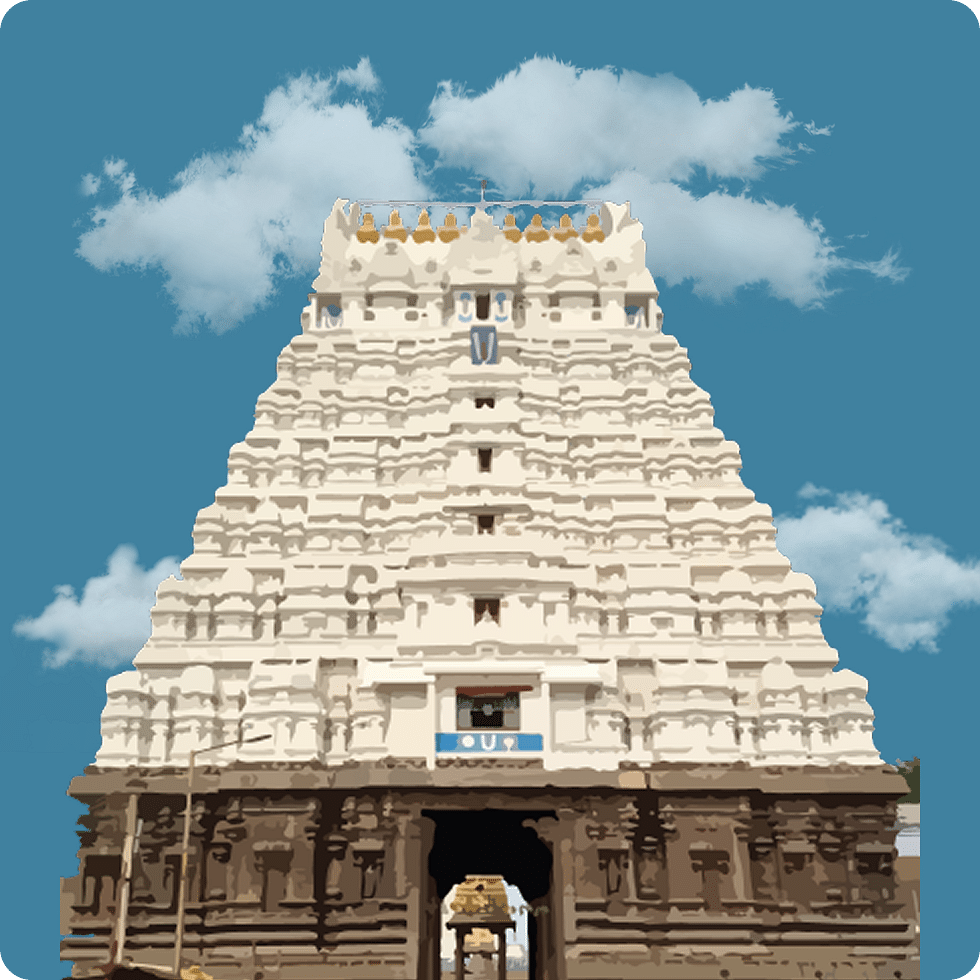
_04d61236)
SHRI CHITRAGUPTA SWAMY
TEMPLE ✨
This temple is one of the few dedicated to Chitragupta, Yama’s trusty helper. Here, devotees don’t just bring offerings—they come hoping to clear their karmic records, maybe get a divine audit, or just check if there’s a grace marks policy in the celestial ledger!
Distance from Our Hotel3 km
Timing7:00 a.m. to 12:00 p.m.
4:00 p.m. to 8:30 p.m.FestivalChitra Pournami: (Apr-May)
Transportation CostFor assistance, please contact the front desk.
Disclaimer: The temple's timings are subject to change as per the operating committee's decisions.
About Shri Chitragupta Swamy Temple:
- Shri Chitragupta Swamy Temple in Kanchipuram is the only temple in India dedicated to Chitragupta, the divine accountant of Yama, the god of death.
- The idol of Chitragupta was discovered buried underground in 1905, but its actual age remains unknown.
- The temple is managed by the Karuneegar community, which is traditionally associated with writing and record-keeping.
- Chitragupta is believed to record every human's deeds, deciding their fate in the afterlife.
- Devotees visit the temple, especially those facing hardships due to Ketu's planetary influence, seeking relief and blessings.
- The temple hosts a grand festival on Chitra Pournami, celebrating Chitragupta’s birth, with special pujas and rituals.
- Located near the Kanchipuram bus stand, the temple remains a revered spiritual centre, drawing devotees from across India.
Divine Facts:
Once upon a celestial moment, Yama, the god of death, found himself drowning in, well… too much work. Too many souls, too many deeds, and let’s be honest, way too much cosmic admin. Frustrated, he knocked on the doors of the heavens, filing an urgent request: “I need backup!” Enter Lord Shiva, the ultimate problem solver. With a flick of divine creativity, he sketched the outline of a being in the heavens. Then, Goddess Parvati, ever the nurturer, breathed life into it. And just like that—boom!—Chitragupta was born. Blessed with wisdom sharper than a sage’s quill, Chitragupta was assigned a sacred job: keeping the ultimate ledger—the Akashic records. Every soul’s karma, whether saintly, shady, or somewhere in between, was now under his watchful eye. Even Surya, the radiant Sun God, gave him a cosmic thumbs-up before sending him off to assist Yama. From that day forward, Chitragupta became the silent force behind cosmic justice, ensuring that every action had its due consequence. His temple stands as a symbol of karmic balance, where devotees don’t just come with offerings but with hopes—maybe to clear their records, maybe to get a divine audit, or maybe, just maybe, to see if the celestial ledger has a grace marks policy. Because let’s be honest—when it comes to karma, having the record-keeper on your side is never a bad idea!ARULMIGU SRI ULAGALANDA PERUMAL TEMPLE ✨
A Dravidian-style temple where Vishnu stands as Trivikrama—one foot on the Earth, the other stretching to the skies, with fingers pointing to the heavens. It's a constant reminder of the epic tale when he humbled the mighty King Mahabali!
Distance from Our Hotel3 km
Timing6:00 a.m. to 12:00 p.m.
4:00 p.m. to 8:00 p.m.FestivalBrahmotsavam: (Sep-Oct)
Navarathri: (Sep-Oct)
Panguni Uthiram: (Mar-Apr)
Theppotsavam: (Apr-May)
Vamana Jayanthi: (Aug-Sep)
Tamil New Year: (Apr)
Marghazi Masam: (Dec-Jan)Sacred Food OfferedVen pongal
Transportation CostFor assistance, please contact the front desk.
Disclaimer: The temple's timings are subject to change as per the operating committee's decisions.
About Arulmigu Sri Ulagalanda Perumal Temple:
- Sri Ulagalantha Perumal Temple in Kanchipuram is one of the most revered Vishnu temples in Tamil Nadu, dedicated to Lord Vishnu in his Trivikrama (Ulagalantha Perumal) form.
- The deity is depicted with one foot on Earth and the other lifted towards the sky, symbolising his cosmic presence.
- Originally built by the Pallavas, the temple was later expanded by the Cholas, Vijayanagara Kings, and Madurai Nayaks, reflecting a blend of historical influences.
- Covering 60,000 sq. ft., the temple follows the Dravidian architectural style and features three towering Rajagopurams, with the tallest adorned with seven kalasas.
- This temple is unique as it houses four Divya Desams—Thiru Ooragam, Thiru Kaarvaanam, Thiru Kaaragam, and Thiru Neeragam—within the same complex.
- The Moolavar (presiding deity) is one of the largest among Divya Desams, standing at over 30 ft. tall, making it a breathtaking sight for devotees.
- The temple has a sacred temple tank known as Naga Tirtha, located just outside the complex.
- Major festivals celebrated here include the Brahmotsavam (January–February) and Vamana Jayanthi (August–September), drawing thousands of devotees.
- Ancient inscriptions within the temple document land grants and donations from various ruling dynasties.
- The temple is praised in the Naalayira Divya Prabandham, an ancient Tamil Vaishnavite scripture, highlighting its spiritual significance.
Divine Facts:
Long, long ago—when sages still walked barefoot across galaxies and kings ruled with both valour and vows—there lived a mighty asura king named Mahabali. Grandson of the great Prahlada, Mahabali was smart, strong, and had a heart so generous it could’ve funded half the heavens. But like most ambitious rulers with too many victory medals, he got a little carried away. One fine day, Mahabali decided that Earth wasn’t enough—he wanted the keys to heaven too. So, he marched into Indra’s heavenly kingdom and took over. Indra, left with no throne and a bruised ego, did what even the mightiest of gods might do in a cosmic crisis—he turned to the one person who always listens: his mother, Aditi. And Aditi, with the calm of a thousand sunsets and the determination only a divine mom could muster, took the matter straight to Lord Vishnu. Now, Vishnu didn’t storm in with lightning or cosmic battle cries. Nope. He chose something far more strategic: a humble, adorable Brahmin boy named Vamana—tiny frame, big mission. Vamana walked into Mahabali’s grand ritual like he was just there for some prasadam. Then, casually, he asked for three steps of land. Just three. Mahabali laughed, the crowd laughed, even the yagna fire probably flickered in amusement. ‘Only three? Granted!’ But plot twist: This wasn’t your average barefoot pilgrim. The moment Mahabali made his vow, Vamana leveled up. And up. And up. Before anyone could blink, he transformed into Trivikrama, a towering form of Vishnu who could basically high-five the stars. One step—he covered the Earth. Second step—he took over heaven (sorry, Indra, again). And then came the big question: ‘Where do I place the third?’ Mahabali, realizing he was now out of space and options, did the most kingly thing possible—he bowed down and offered his head. Talk about surrendering with style. Instead of crushing him, Vishnu gently placed his foot on Mahabali’s head. And rather than punishment, the king got a reward—immortality, honor, and a VIP pass to rule the netherworld. Honestly? Not a bad deal for a day that started with a yagna and ended with universal realignment. And that’s the story behind Ulagalandha Perumal Temple—where Lord Vishnu stands tall (literally) as Trivikrama, reminding us all that humility, even in the face of cosmic surprises, never goes unnoticed.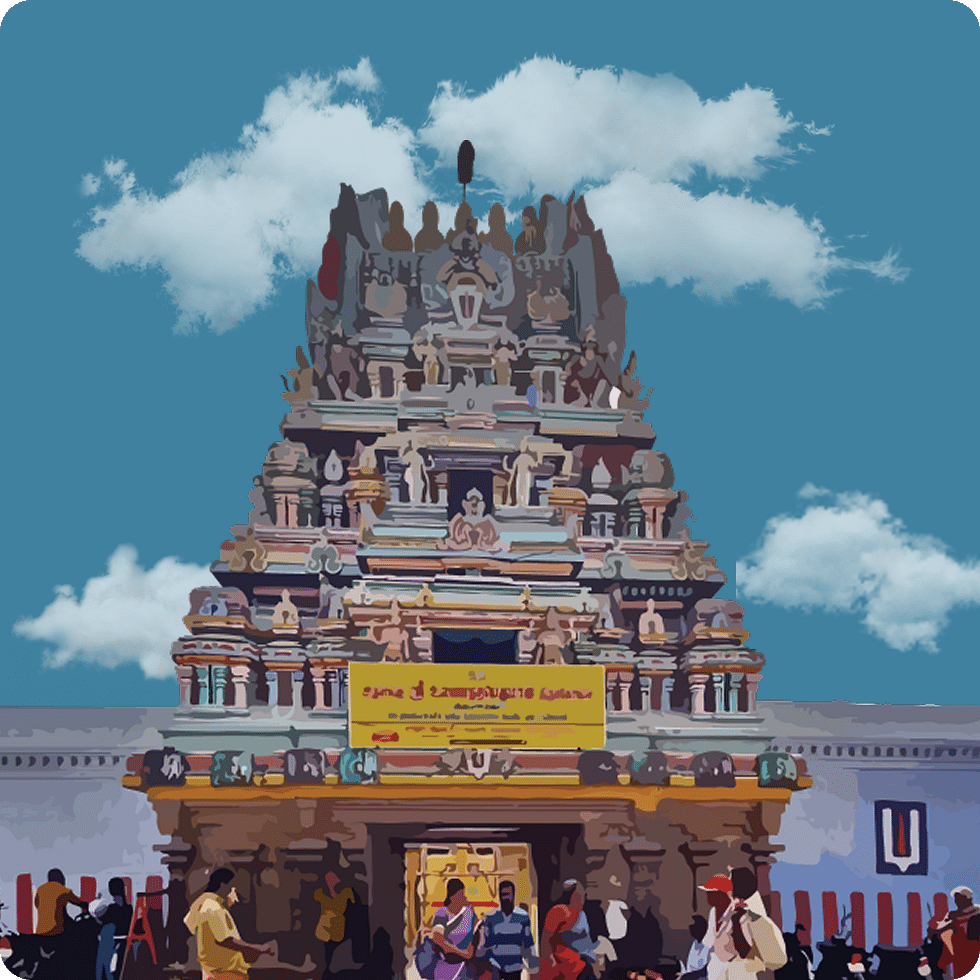
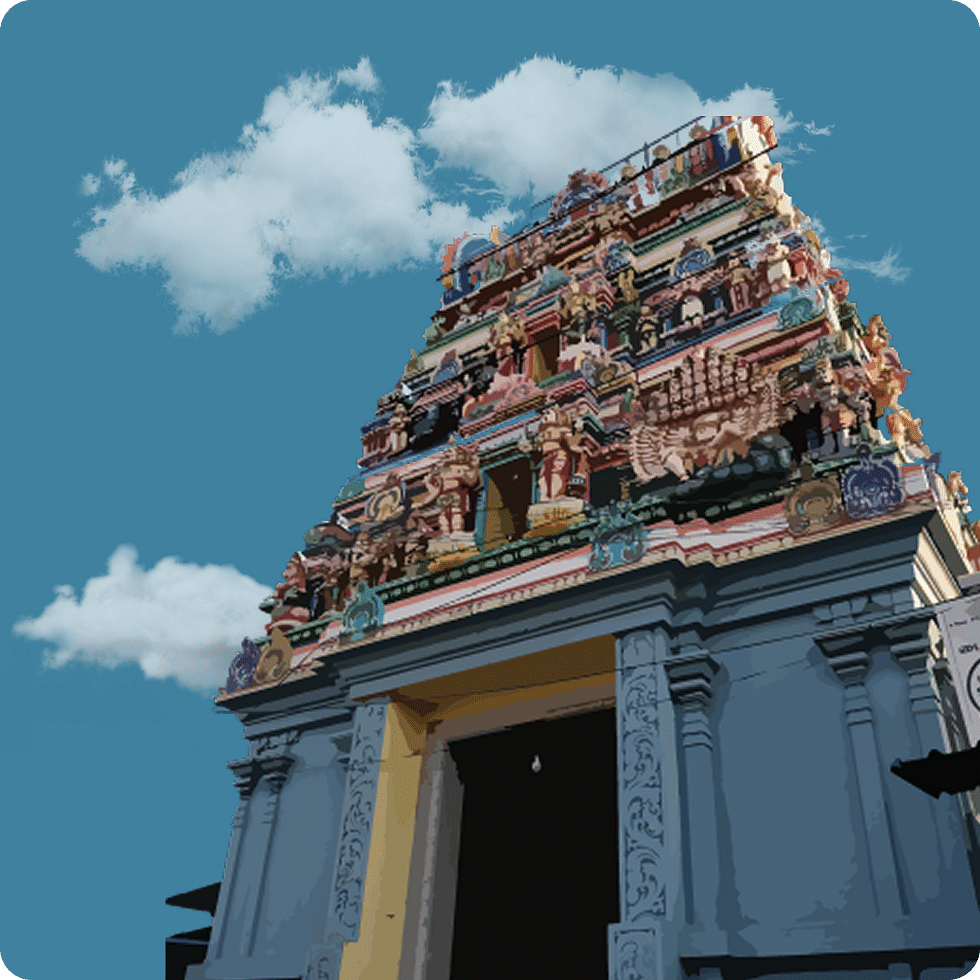
SRI VAZHAKARUTHEESWARAR
TEMPLE ✨
The temple is like a divine courtroom, way before courts were a thing—where Lord Mahadeva himself settled disputes. That's how it earned the name Vazhakarutheeswarar—the One Who Ends All Disputes!
Distance from Our Hotel1 km
Timing6:00 a.m. to 12:00 p.m.
4:00 p.m. to 8:30 p.m.FestivalMahashivarathri: (Feb-Mar)
Navarathri: (Sep-Oct)
Annamalai Deepam: (Nov-Dec)
Pongal: (Jan)
Tamil New Year: (Apr)Sacred Food OfferedPuliyodharai
Transportation CostFor assistance, please contact the front desk.
Disclaimer: The temple's timings are subject to change as per the operating committee's decisions.
About Sri Vazhakarutheeswarar Temple:
- Located in Kanchipuram, Sri Vazhakarutheeswarar Temple is an ancient temple dedicated to Lord Shiva, known as ‘The God Who Solves Cases’.
- The temple is believed to be over 1,000 years old and holds deep significance for those facing legal disputes and court cases.
- Devotees perform special pujas and abhishekams on 16 consecutive monday's to seek justice and favourable outcomes.
- The presiding deity, Vazhakarutheeswarar (Shiva Lingam), is a unique sixteen-sided Shodasha Lingam, symbolising sixteen types of blessings for material and spiritual prosperity.
- The temple also houses a shrine for Parasareshwarar, a lingam installed by Sage Parashar.
- Architectural marvels include an east-facing sanctum, a three-tiered Rajagopuram, and a sacred temple pond (Thirukulam) in front.
Divine Facts:
Back in the days when the universe was still in draft mode and stars were being pinned into place, a rather unexpected debate broke out—not about galaxies or gravity, but over something far more profound: the Vedas. Yes, those sacred texts became a heated argument between the sages and the devas. Now usually, when things get tense in the divine realm, Lord Vishnu gets a call. But this time? The exhausted parties decided to try something different. They knocked on the door of Kailasa and approached none other than Lord Shiva. You’d expect the mighty Lord of Tandava, draped in serpents and silence, to bring thunder to the table. But not this time. With a calmness that could silence a storm, Shiva stepped in—not with a trident, but with timeless wisdom. No fire. No fury. No dramatic cosmic showdown. Just a quiet solution that settled the stormy debate in one sweep. That moment wasn’t just peace-making—it was parashakthi-level peacemaking. And from that day on, Shiva earned a special title: Vazhakarutheeswarar—the One Who Ends All Disputes. His temple stands today as a reminder that even in an era of celestial arguments, resolution comes not through might, but through clarity. Devotees come here not just with offerings, but sometimes with their own earthly conflicts—because let’s face it, if Shiva could settle a divine Vedic debate, he can probably handle that one stubborn relative too.KANCHI KAMAKOTI PEETHAM TEMPLE ✨
From the sacred heights of Mount Kailash, Adi Shankaracharya journeyed far and wide, reaching the holy city of Kanchipuram. Tasked with preserving dharma, he consecrated a sacred Linga, founding the Kanchi Kamakoti Peetham—more than just a monastery, it became a beacon of Advaita Vedanta and a sanctuary blessed by Goddess Kamakshi.
Distance from Our Hotel2 km
Timing6:00 a.m. to 12:30 p.m.
4:00 p.m. to 8:00 p.m.FestivalSkanda Shashti: (Oct-Nov)
Rathotsavams: (Feb)
Shukravara Puja: (Apr)
Tulasi Vivaham: (Nov)
Brindaavana Dwadashi: (Nov)
Annabhishekam: (Oct-Nov)
Pournami Puja: (Apr)Sacred Food OfferedFruits
Transportation CostFor assistance, please contact the front desk.
Disclaimer: The temple's timings are subject to change as per the operating committee's decisions.
About Kanchi Kamakoti Peetham Temple:
- Kanchi Kamakoti Peetham is one of the five major Shankaracharya Peethams established by Adi Shankaracharya.
- It is believed to have been established in Kanchipuram, a city known for its spiritual and scholarly significance.
- The Peetham follows the Advaita Vedanta philosophy, emphasising the non-dual nature of reality.
- The lineage of saints at the Peetham has contributed to the spread of Vedic knowledge and spiritual teachings.
- It is closely associated with Goddess Kamakshi, whose temple is a revered pilgrimage site in Kanchipuram.
- The institution actively engages in religious, social, and educational activities, preserving ancient traditions.
- The Peetham has played a vital role in Sanskrit scholarship and Vedic studies for centuries.
- Festivals, Vedic rituals, and discourses are regularly conducted, attracting devotees from all over India.
Divine Facts:
Centuries ago, in a time when spiritual debates were hotter than summer in Tamil Nadu, Adi Shankaracharya was on a mission. Not just any mission—he was single-handedly trying to revive Sanatana Dharma across India, and he wasn’t doing it in slow motion. At an age when most kids are still figuring out multiplication tables, Shankara was dropping Advaita Vedanta truths like divine mic drops. From Kashmir to Kerala, he walked, talked, and transformed hearts. But destiny, as it turns out, had saved the grand finale for Kanchipuram—a city so drenched in divinity, it practically glows. Now, Shankara had visited many sacred cities, but there was something undeniably unique about Kanchi. Perhaps it was the sacred stillness that seemed to wrap around the town like a silken prayer. Perhaps it was the centuries of penance and devotion soaked into its soil. Or perhaps—just perhaps—it was the gentle, unseen presence of Goddess Kamakshi, silently guiding him, drawing him closer with the quiet insistence of destiny. And she spoke—not with words, but with a silence that carried the weight of the cosmos. It wasn’t a command, but a calling. Kamakshi willed it, and Shankara knew. His journey had found its home. The sacred land of Kanchi, vibrant with divine energy, wasn’t just another stop—it was the destination. A place where stillness met purpose and where the seeds of something timeless were meant to take root. So, Shankara listened. He settled. And right there in the sacred heart of Kanchi, he established the Kanchi Kamakoti Peetham—not just a monastery, but a lighthouse of truth, radiating knowledge and grace across generations. The rest, as they say, is history—or in this case, eternal legacy. Because from that moment on, Kanchipuram wasn’t just one of the seven Moksha-puris. It became the spiritual headquarters of Advaita Vedanta, approved and blessed by none other than Kamakshi herself. Even today, if you stand near the Peetham and close your eyes, you might just feel it—that silent whisper of the goddess, the echo of a sage who stayed, and the legacy that continues to shine through time.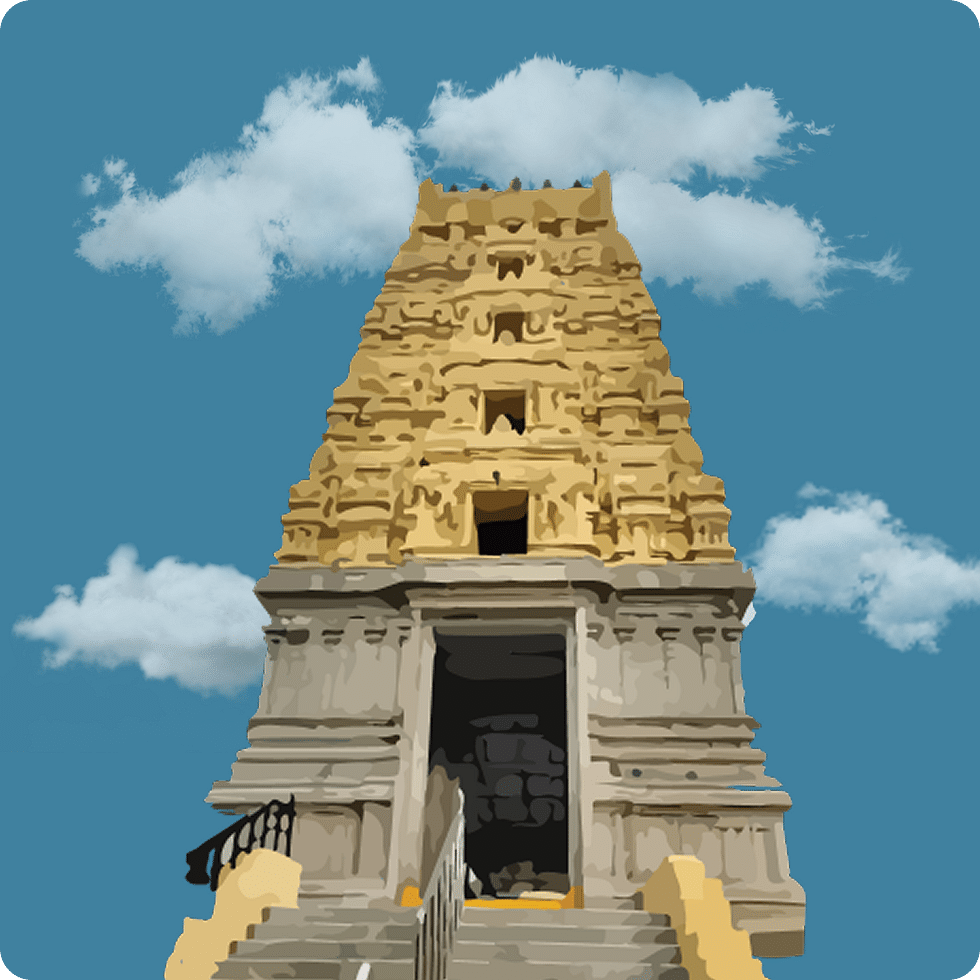
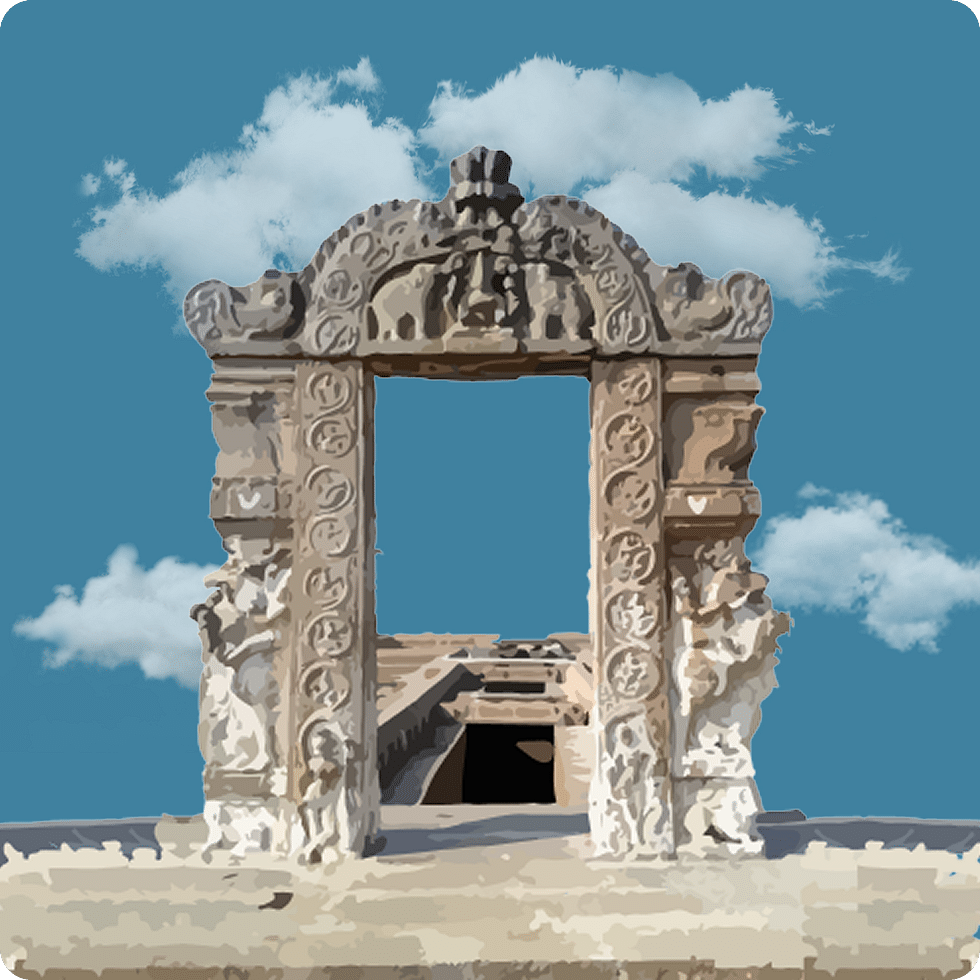
SANJEEVIRAYAR TEMPLE ✨
A tale of how being a devoted Hanuman follower ensures no trial is too great. A sage, interrupted by goons during his travels, called upon Hanuman, and in a flash, the god saved him. To honour this divine intervention, the sage built a temple, forever marking his gratitude.
Distance from Our Hotel8 km
Timing7:00 a.m. to 1:00 p.m.
4:00 p.m. to 8:00 p.m.FestivalHanuman Jayanthi: (Apr)
Sri Rama Navami: (Apr)
Pongal: (Jan)
Navarathri: (Sep-Oct)
Chitra Pournami: (Apr-May)Sacred Food OfferedThulasi theertham
Transportation CostFor assistance, please contact the front desk.
Disclaimer: The temple's timings are subject to change as per the operating committee's decisions.
About Sanjeevirayar Temple:
- Built in the Vijayanagara era, the Sanjeevirayar temple in Ayyangar Kulam, near Kanchipuram, is dedicated to Sri Hanuman, revered here as Sri Sanjeevirayar.
- The temple’s legend connects to the Ramayana, as it is believed that fragments of the Sanjeevi Hill fell at this very site when Hanuman carried it to Lanka.
- The temple features a grand sanctum with a six-foot-tall idol of Hanuman in Anjali Hasta (prayer pose) facing north.
- A unique inscription of the Hanumad Vimshati, composed by the temple’s founder, Lakshmikumara Tatacharya, is carved within its sacred walls.
- A key highlight is the vast temple tank, Lakshmi Saras, which spans 150 acres, enhancing the sanctity of the temple.
- Festivals like Hanumath Jayanthi and Sri Rama Navami are celebrated with grandeur, drawing devotees from far and wide.
Divine Facts:
Many moons ago, the esteemed scholar Lakshmikumara Tatacharya was returning from a sacred pilgrimage, minding his own spiritual business. As he approached Ayyangar Kulam, however, fate had a rather inconvenient plot twist in store—bandits, swords shining like they were auditioning for a Bollywood villain role, suddenly surrounded him. Escape? Not happening. But Tatacharya wasn’t packing any weapons—he was armed with something far more powerful: unwavering faith. With the bandits closing in, he turned inward, called upon the mighty Hanuman, and composed twenty powerful Sanskrit verses on the spot. These would later become the revered Hanumad Vimshati. As the final verse left his lips, something extraordinary happened—like a cosmic power surge, a mysterious energy filled the air. The bandits? They suddenly looked like they’d seen a ghost and fled in panic, scattering like autumn leaves caught in a gust of wind. Grateful and in awe, Tatacharya decided to honor Hanuman in the grandest way he could think of: by building a temple on that very sacred spot. And so, a temple rose, with those twenty verses carved into its walls, an eternal tribute to the day when faith literally chased away danger. Even today, the air around the temple still hums with that same energy. Every prayer and chant carries the echo of that moment when faith turned the tide—and Hanuman was there to answer the call.VARADHARAJA PERUMAL TEMPLE ✨
When Lord Brahma found himself in a critical jam, who else but Vishnu swooped in to save the day? Not only did Vishnu rescue him, but out of love for his devotees, he decided to stick around, transforming into Devaraja Swamy.
Distance from Our Hotel2 km
Timing6:00 a.m. to 12:30 p.m.
3:30 p.m. to 8:30 p.m.FestivalVaikasi Brahmotsavam: (May-Jun)
Garuda Sevai: (May)
Pavitrotsavam: (May)
Navaratri: (Sep-Oct)
Deepavali: (Oct-Nov)
Karthigai Deepam: (Nov-Dec)
Vaikunta Ekadasi: (Dec)
Thai Poosam: (Jan)
Panguni Uthiram: (Mar-Apr)
Chitra Pournami: (Apr-May)Sacred Food OfferedThattai vadai, Kanchipuram kovil idli
Transportation CostFor assistance, please contact the front desk.
Disclaimer: The temple's timings are subject to change as per the operating committee's decisions.
About Varadharaja Perumal Temple:
- Varadharaja Perumal Temple, also known as Hastigiri, is a revered Vishnu temple located in Kanchipuram, Tamil Nadu.
- It is one of the 108 Divya Desams, the sacred Vishnu temples glorified by the Alvars, the poet saints of Vaishnavism.
- The temple was originally built by the Cholas in 1053 AD and later expanded by the Vijayanagara rulers, showcasing breathtaking Dravidian architecture.
- One of the temple’s marvels is the stone chain carved from a single rock, a masterpiece of Vijayanagara craftsmanship.
- The temple is home to a wooden idol of Lord Varadharaja, known as Athi Varadar, which is submerged in the temple tank and brought out for worship once every 40 years
- The sanctum features the Punyakoti Vimanam, and the temple houses numerous mandapas, including the renowned 100-pillared hall with intricate carvings from the Ramayana and Mahabharata.
- The temple’s grand annual festival, the Vaikasi Brahmotsavam, draws 1,000s of devotees for an elaborate 10-day celebration.
- The sacred Lizard Sculptures in gold and silver are believed to absolve sins when touched by devotees.
Divine Facts:
Once upon a time, in the lively land of Kanchipuram, Lord Brahma decided to host the ultimate yagna party to honour Lord Vishnu. The chants were on point, the flames were blazing, and everything was going perfectly—until Goddess Saraswati, a little ticked off due to a feud with Brahma, decided to stir things up. She took the form of the mighty Vegavathi River (now known as the Palar River), and, in a fit of divine frustration, threatened to wash away all the sacred vibes—along with Brahma’s hard work. Cue Lord Vishnu, the cosmic superhero, who stepped in without a second thought. He stretched himself across the river like a living dam, making even the most seasoned engineers look like amateurs. The river stopped. The yagna was saved. Brahma, breathing a sigh of relief, was filled with gratitude and awe. Vishnu emerged from the fire in his most radiant form, shining brighter than a thousand suns as Devaraja Swamy. Brahma, eager to show his appreciation, asked Vishnu to stay, knowing that his divine presence would bless the devotees forever. Ever humble, Lord Vishnu agreed and manifested as Devaraja Swamy, casting a glow that could light up the heavens. And thus, the Varadharaja Perumal Temple was born—a divine symbol of grace, protection, and the simple truth that faith can calm even the wildest floods. To this day, Lord Varadharaja blesses everyone who walks through those sacred halls, proving that with faith on your side, no crisis is too big to handle! But wait, there’s more. Hidden beneath the waters of the temple tank lies a legend that stirs once every 40 years. Meet Athi Varadar—a 9-foot wooden idol of Lord Varadharaja, carved from the sacred fig tree by none other than Vishwakarma himself. This divine form, kept submerged in a silver casket, rises from the depths only once in four decades, resting in Vasantha Mandapam for 48 days—24 in a peaceful slumber, and 24 standing tall in blessing.